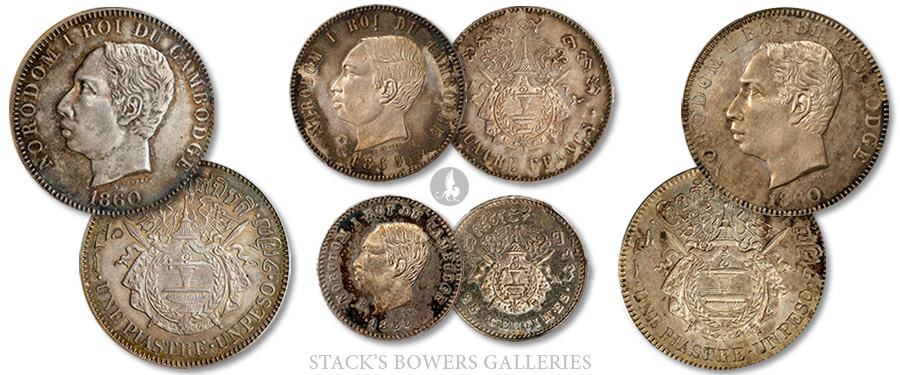
By 1860 massive change was occurring in Southeast Asia. Growing European influence, particularly that of the French Empire, was encroaching on traditional kingdoms and rulers. In this tumultuous time, Cambodia found itself dealing with the influence of the French and the rival Kingdom of Siam (modern day Thailand). The French influence did lead to a revolution of sorts in coinage for the region, with Thailand adopting their first "flat" European style machine struck coinage in 1860, with Cambodia also producing some of the country’s first machine struck coinage (examples from 1847 were also machine struck). In 1860 some of the most famous Cambodian issues were produced, coinciding with the inaugural year of the reign of Norodom I.
Norodom I was born into the Cambodian royal family in 1834, at a time when Cambodia was largely subservient to the Kingdom of Siam. Assuming the throne in 1860, it was not long before his rule faced challenges. In 1861 Norodom’s half-brother rebelled and Norodom was forced to flee. He returned to the throne in 1862, but his position was much weakened, and he signed a treaty placing himself under French protection in 1863. By 1884, the French wanted even more from Cambodia, demanding control of public revenue and infrastructure. This centralized French control led to the Kingdom of Cambodia’s incorporation into French Indochina when it was formed in 1887, a system that rendered Norodom all but a French puppet. Norodom retained his throne and titles until his death in 1904 in his palace in Phnom Penh. He had been a ruler in name for 44 years, but almost never a ruler in practice.
Despite Cambodia’s largely vassal status in the French sphere of influence, the role of Norodom I as monarch of Cambodia is celebrated on the coinage of Cambodia dated 1860, which includes many denominations, patterns, specimens, and restrikes. In the May Hong Kong Auction Stack’s Bowers Galleries offers some of these interesting types for sale. Of particular note is an immaculate PCGS graded Proof-65 Piastre from 1860 produced by the Brussels Mint. Proof issues are an order of magnitude rarer than business strikes and restrikes of the type, with only a handful reaching the market over the past decade. For collectors looking for a Mint State example, the May auction offers two of these, graded PCGS MS-62 and MS-63 respectively. Despite being more common, these issues are still hugely popular and certain to attract strong bids from collectors.
Essai strikes were included in the issues of 1860 and they are also of the highest rarity. Though many coins that are French or French related spell the word "ESSAI" out on the coin, these examples differ in that they only contain the letter "E" followed by a period to distinguish them as patterns. Of these types Stacks Bowers Galleries offers a 4 Francs Essai graded Specimen-64 by PCGS and a 25 Centimes graded Specimen-66 by PCGS.
These Cambodian pieces are sure to attract much attention given the strength of the collector base for the 1860 types. These items, along with over 7,500 other lots of world coins related to Asian numismatics are now available for viewing and bidding at stacksbowers.com. We are always seeking world and ancient coins, medals, and paper money for our auctions, and are currently accepting consignments for our August 2022 Global Showcase Auction and our October Collectors Choice Online (CCO) sale. If you would like to learn more about consigning, whether a singular item or an entire collection, please contact a consignment director or email info@stacksbowers.com today and we will assist you in achieving the best possible return on your material.





